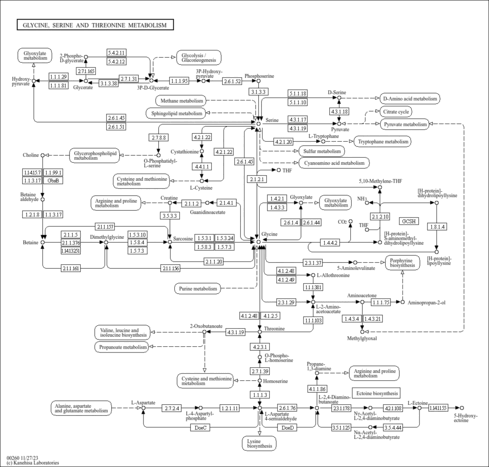| Aminoacetone,1TMS,isomer #1 | CC(=CN)O[Si](C)(C)C | 991.1 | Semi standard non polar | 33892256 |
| Aminoacetone,1TMS,isomer #1 | CC(=CN)O[Si](C)(C)C | 939.7 | Standard non polar | 33892256 |
| Aminoacetone,1TMS,isomer #1 | CC(=CN)O[Si](C)(C)C | 1410.2 | Standard polar | 33892256 |
| Aminoacetone,1TMS,isomer #2 | C=C(CN)O[Si](C)(C)C | 902.5 | Semi standard non polar | 33892256 |
| Aminoacetone,1TMS,isomer #2 | C=C(CN)O[Si](C)(C)C | 928.9 | Standard non polar | 33892256 |
| Aminoacetone,1TMS,isomer #2 | C=C(CN)O[Si](C)(C)C | 1399.4 | Standard polar | 33892256 |
| Aminoacetone,1TMS,isomer #3 | CC(=O)CN[Si](C)(C)C | 954.2 | Semi standard non polar | 33892256 |
| Aminoacetone,1TMS,isomer #3 | CC(=O)CN[Si](C)(C)C | 912.3 | Standard non polar | 33892256 |
| Aminoacetone,1TMS,isomer #3 | CC(=O)CN[Si](C)(C)C | 1268.5 | Standard polar | 33892256 |
| Aminoacetone,2TMS,isomer #1 | CC(=CN[Si](C)(C)C)O[Si](C)(C)C | 1162.6 | Semi standard non polar | 33892256 |
| Aminoacetone,2TMS,isomer #1 | CC(=CN[Si](C)(C)C)O[Si](C)(C)C | 1116.7 | Standard non polar | 33892256 |
| Aminoacetone,2TMS,isomer #1 | CC(=CN[Si](C)(C)C)O[Si](C)(C)C | 1182.5 | Standard polar | 33892256 |
| Aminoacetone,2TMS,isomer #2 | C=C(CN[Si](C)(C)C)O[Si](C)(C)C | 1099.2 | Semi standard non polar | 33892256 |
| Aminoacetone,2TMS,isomer #2 | C=C(CN[Si](C)(C)C)O[Si](C)(C)C | 1140.8 | Standard non polar | 33892256 |
| Aminoacetone,2TMS,isomer #2 | C=C(CN[Si](C)(C)C)O[Si](C)(C)C | 1136.7 | Standard polar | 33892256 |
| Aminoacetone,2TMS,isomer #3 | CC(=O)CN([Si](C)(C)C)[Si](C)(C)C | 1188.5 | Semi standard non polar | 33892256 |
| Aminoacetone,2TMS,isomer #3 | CC(=O)CN([Si](C)(C)C)[Si](C)(C)C | 1141.1 | Standard non polar | 33892256 |
| Aminoacetone,2TMS,isomer #3 | CC(=O)CN([Si](C)(C)C)[Si](C)(C)C | 1169.1 | Standard polar | 33892256 |
| Aminoacetone,3TMS,isomer #1 | CC(=CN([Si](C)(C)C)[Si](C)(C)C)O[Si](C)(C)C | 1374.0 | Semi standard non polar | 33892256 |
| Aminoacetone,3TMS,isomer #1 | CC(=CN([Si](C)(C)C)[Si](C)(C)C)O[Si](C)(C)C | 1232.8 | Standard non polar | 33892256 |
| Aminoacetone,3TMS,isomer #1 | CC(=CN([Si](C)(C)C)[Si](C)(C)C)O[Si](C)(C)C | 1217.5 | Standard polar | 33892256 |
| Aminoacetone,3TMS,isomer #2 | C=C(CN([Si](C)(C)C)[Si](C)(C)C)O[Si](C)(C)C | 1330.0 | Semi standard non polar | 33892256 |
| Aminoacetone,3TMS,isomer #2 | C=C(CN([Si](C)(C)C)[Si](C)(C)C)O[Si](C)(C)C | 1293.4 | Standard non polar | 33892256 |
| Aminoacetone,3TMS,isomer #2 | C=C(CN([Si](C)(C)C)[Si](C)(C)C)O[Si](C)(C)C | 1185.4 | Standard polar | 33892256 |
| Aminoacetone,1TBDMS,isomer #1 | CC(=CN)O[Si](C)(C)C(C)(C)C | 1196.9 | Semi standard non polar | 33892256 |
| Aminoacetone,1TBDMS,isomer #1 | CC(=CN)O[Si](C)(C)C(C)(C)C | 1161.6 | Standard non polar | 33892256 |
| Aminoacetone,1TBDMS,isomer #1 | CC(=CN)O[Si](C)(C)C(C)(C)C | 1608.5 | Standard polar | 33892256 |
| Aminoacetone,1TBDMS,isomer #2 | C=C(CN)O[Si](C)(C)C(C)(C)C | 1117.5 | Semi standard non polar | 33892256 |
| Aminoacetone,1TBDMS,isomer #2 | C=C(CN)O[Si](C)(C)C(C)(C)C | 1129.9 | Standard non polar | 33892256 |
| Aminoacetone,1TBDMS,isomer #2 | C=C(CN)O[Si](C)(C)C(C)(C)C | 1567.1 | Standard polar | 33892256 |
| Aminoacetone,1TBDMS,isomer #3 | CC(=O)CN[Si](C)(C)C(C)(C)C | 1206.5 | Semi standard non polar | 33892256 |
| Aminoacetone,1TBDMS,isomer #3 | CC(=O)CN[Si](C)(C)C(C)(C)C | 1150.3 | Standard non polar | 33892256 |
| Aminoacetone,1TBDMS,isomer #3 | CC(=O)CN[Si](C)(C)C(C)(C)C | 1368.7 | Standard polar | 33892256 |
| Aminoacetone,2TBDMS,isomer #1 | CC(=CN[Si](C)(C)C(C)(C)C)O[Si](C)(C)C(C)(C)C | 1613.6 | Semi standard non polar | 33892256 |
| Aminoacetone,2TBDMS,isomer #1 | CC(=CN[Si](C)(C)C(C)(C)C)O[Si](C)(C)C(C)(C)C | 1532.8 | Standard non polar | 33892256 |
| Aminoacetone,2TBDMS,isomer #1 | CC(=CN[Si](C)(C)C(C)(C)C)O[Si](C)(C)C(C)(C)C | 1473.4 | Standard polar | 33892256 |
| Aminoacetone,2TBDMS,isomer #2 | C=C(CN[Si](C)(C)C(C)(C)C)O[Si](C)(C)C(C)(C)C | 1515.8 | Semi standard non polar | 33892256 |
| Aminoacetone,2TBDMS,isomer #2 | C=C(CN[Si](C)(C)C(C)(C)C)O[Si](C)(C)C(C)(C)C | 1538.7 | Standard non polar | 33892256 |
| Aminoacetone,2TBDMS,isomer #2 | C=C(CN[Si](C)(C)C(C)(C)C)O[Si](C)(C)C(C)(C)C | 1451.5 | Standard polar | 33892256 |
| Aminoacetone,2TBDMS,isomer #3 | CC(=O)CN([Si](C)(C)C(C)(C)C)[Si](C)(C)C(C)(C)C | 1576.4 | Semi standard non polar | 33892256 |
| Aminoacetone,2TBDMS,isomer #3 | CC(=O)CN([Si](C)(C)C(C)(C)C)[Si](C)(C)C(C)(C)C | 1563.7 | Standard non polar | 33892256 |
| Aminoacetone,2TBDMS,isomer #3 | CC(=O)CN([Si](C)(C)C(C)(C)C)[Si](C)(C)C(C)(C)C | 1414.5 | Standard polar | 33892256 |
| Aminoacetone,3TBDMS,isomer #1 | CC(=CN([Si](C)(C)C(C)(C)C)[Si](C)(C)C(C)(C)C)O[Si](C)(C)C(C)(C)C | 1980.4 | Semi standard non polar | 33892256 |
| Aminoacetone,3TBDMS,isomer #1 | CC(=CN([Si](C)(C)C(C)(C)C)[Si](C)(C)C(C)(C)C)O[Si](C)(C)C(C)(C)C | 1861.1 | Standard non polar | 33892256 |
| Aminoacetone,3TBDMS,isomer #1 | CC(=CN([Si](C)(C)C(C)(C)C)[Si](C)(C)C(C)(C)C)O[Si](C)(C)C(C)(C)C | 1613.9 | Standard polar | 33892256 |
| Aminoacetone,3TBDMS,isomer #2 | C=C(CN([Si](C)(C)C(C)(C)C)[Si](C)(C)C(C)(C)C)O[Si](C)(C)C(C)(C)C | 1925.8 | Semi standard non polar | 33892256 |
| Aminoacetone,3TBDMS,isomer #2 | C=C(CN([Si](C)(C)C(C)(C)C)[Si](C)(C)C(C)(C)C)O[Si](C)(C)C(C)(C)C | 1914.7 | Standard non polar | 33892256 |
| Aminoacetone,3TBDMS,isomer #2 | C=C(CN([Si](C)(C)C(C)(C)C)[Si](C)(C)C(C)(C)C)O[Si](C)(C)C(C)(C)C | 1601.6 | Standard polar | 33892256 |
